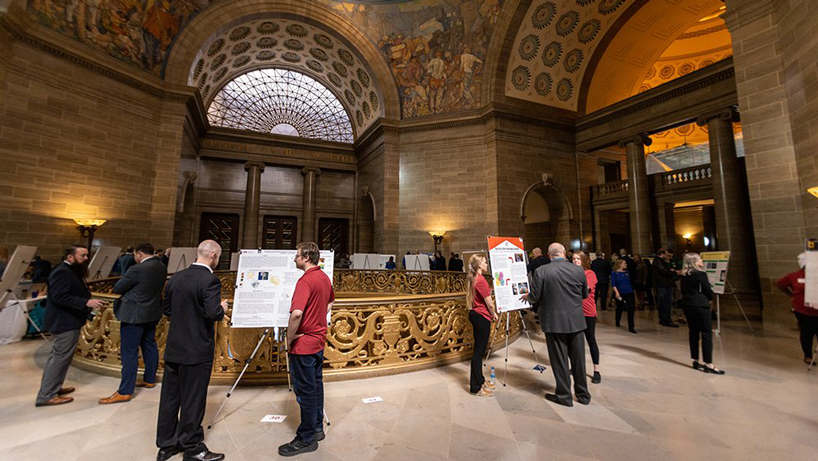
UMSL students give poster presentations last Thursday at the Missouri State Capitol as part of the University of Missouri System’s Undergraduate Research Day. (Photos courtesy of UM System)
Twelve University of Missouri–St. Louis students showcased their work for and took questions from legislators, government officials and other stakeholders at the Missouri State Capitol during the University of Missouri System Undergraduate Research Day on Thursday in Jefferson City, Missouri.
The UMSL students joined 36 other students from across the UM System’s other three universities for the event, which is an opportunity for them to present their hard work and highlight the synergy between students and faculty mentors.
Twelve UMSL students presented their research projects during the University of Missouri System’s Undergraduate Research Day, and they joined UM System President Mun Choi for a photo on the staircase in the rotunda of the Missouri State Capitol.
“As the state’s only public research university, our students are provided unique opportunities to work alongside our talented faculty to conduct cutting-edge and groundbreaking research on our four campuses every day,” UM System President Mun Choi wrote in a letter to legislators. “These experiences, which range from science to medicine to the humanities, help to prepare our students for graduate and professional studies at prominent universities as well as careers in leading industries.”
UMSL’s 12 representatives come from a variety of academic disciplines including: biology, chemistry, computer science, nursing and physics. Learn more about the students and their research:
Jake Arbogast, physics; and Jacob Wilson, physics
Faculty mentor: Dawn King, geodetic earth scientist with the National Geospatial-Intelligence Agency
“Evaluating Dimensionality Reduction Parameter Effects on Feature Partitioning”
Arbogast and Wilson’s project concerned the Earth Gravitational Model maintained by the National Geospatial-Intelligence Agency and artificial intelligence methods designed to predict gravity anomalies – essential for the maintenance of the EGM. The project focused specifically on the clustering aspect of an AI pipeline designed to predict the anomalies.
Laurel Bascom, nursing; Yuki Chen, nursing; Celeste Haefner, nursing; Lindsey Marske, nursing; and Olivia Roesner, nursing
Faculty mentor: Kimberly Werner
“Finding the Most Cost Effective Prescription Smoking Cessation Method”
Bascom, Chen, Haefner, Marske and Roesner tackled the issue of smoking, which is one of the leading causes of death and disability in the country. However, low-income smokers often lack access to successful and affordable cessation options. The students analyzed prescription options for smoking cessation and found varenicline (Chantix) to be most cost-effective.
Vijay Muppalla, computer science
Faculty mentor: Trilce Encarnacion
“Public Opinion on the Use of Sidewalk Autonomous Robots for Last-Mile Deliveries”
In light of the rise of online shopping and increased demand for deliveries during the COVID-19 pandemic, Muppala’s research examined the demand for and public sentiment toward Autonomous Delivery Robots. Muppala collected tweets related to ADRs over a nearly three-year period and analyzed them with natural language toolkit programs to breakdown positive and negative sentiment in each tweet.
Zahria Patrick, chemistry
Faculty mentor: Michael Harmata
“The Effect of Variation of N-Substituents on Oxidopyridinium Ions in (4+3) Cycloadditions”
Patrick examined natural product synthesis – a process to synthetically make chemicals that already exist in nature – to test whether two chemicals could be used to create Daphnicyclidin A cycloadducts. The experiment was successful, with both chemicals being able to produce the target compound.
Bri Petty, biology; Jake Venegoni, biology
Faculty mentor: Aimee Dunlap
“An Investigation of the Sublethal Effects of a Biopesticide on Bumblebee Colonies”
Petty and Venegoni studied the biopesticide Botanigard, which is marketed as safe for pollinators while still targeting agricultural pests. However, Botanigard has been shown to affect the cognition and mortality of honeybees. Petty and Venegoni looked at the pesticide’s impact on bombus impatiens, a social bumblebee species important to pollination for crops and flowers, finding that treated bees had lower cognition scores.
Anderson Spencer, biology
Faculty mentor: Aimee Dunlap
“Population surveys of Aphonopelma hentzi in Missouri: Conservation Efforts through Genetic Mapping”
Spencer investigated the viability of extracting DNA from Texas Brown Tarantula molts, as opposed to the traditional removal of “toes,” to determine genetic variance between the populations of tarantulas that have been found in Missouri. The study also tracked and tagged tarantulas to better understand tarantula populations.















